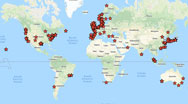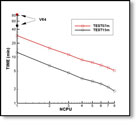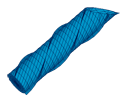Technical Description
WAMIT is a computer program based on the linear and second-order potential theory for analyzing floating or submerged bodies, in the presence of ocean waves. The boundary integral equation method (BIEM), also known as the panel method, is used to solve for the velocity potential and fluid pressure on the submerged surfaces of the bodies. Separate solutions are carried out simultaneously for the diffraction problem, giving the effects of incident waves on the body, and the radiation problems for each of the prescribed modes of motion of the bodies. These solutions are then used to obtain the relevant hydrodynamic parameters including added-mass and damping coefficients, exciting forces, response-amplitude operators (RAO's), the pressure and fluid velocity, and the mean drift forces and moments. The second-order module, Version 6S, provides complete second-order nonlinear quantities in addition.
WAMIT includes several unique options to facilitate its application in the most effective manner. In addition to the conventional low-order method, where the geometry is represented by small quadrilateral panels and the velocity potential is assumed constant on each panel, a powerful higher-order method is also available based on the representation of the potential by continuous B-splines and with a variety of options to define the geometry of the body surface approximately or exactly.
When multiple bodies are considered the hydrodynamic interactions between the bodies are included in the computations, without approximation. In addition to the conventional six degrees of rigid-body motion WAMIT also enables the user to define additional generalized modes to represent a wide variety of physical phenomena including hydroelastic deformations, motions of hinged structures, various types of wave-energy converters, damping of gap and moonpool resonances, wavemakers, etc.
The WAMIT software distribution includes a special utility F2T which is intended to transform first-order frequency-domain outputs to time-domain impulse response functions.
More detailed technical information is contained in the User Manual. Further information and a wide variety of challenging applications are documented in a series of papers listed on the Publications page.








